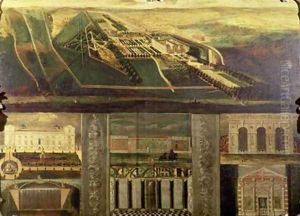Leendert or Leonard Knijff Paintings
Leendert (also known as Leonard) Knijff was a Dutch landscape painter born in 1650 in Weesp, near Amsterdam, in the Netherlands. Belonging to the Dutch Golden Age of painting, Knijff was known for his panoramic landscapes, often depicting tranquil scenes with rolling hills, rivers, and a meticulous rendering of trees and vegetation. His work typically featured the Dutch countryside, showcasing the idyllic and pastoral settings that were popular among art patrons of the time.
Knijff likely received his artistic training in the studio of a local painter, though specific details about his apprenticeship are not well-documented. He might have been influenced by the works of contemporaries such as Meindert Hobbema, Jacob van Ruisdael, and Philips Koninck, who were renowned for their landscape paintings. Knijff’s handling of light and composition suggests that he was well-versed in the techniques and styles that defined the Dutch landscape tradition.
Despite the lack of extensive personal records, Knijff’s paintings themselves provide insight into his artistic journey. He was adept at creating depth in his landscapes through the use of atmospheric perspective, a technique where the clarity of objects decreases with distance, thereby creating an illusion of depth. His work also often included human figures and animals, which added life and narrative to his scenes.
Knijff's later work indicates that he traveled to England, where he painted views of the English countryside, particularly along the River Thames. This period of his career suggests that he enjoyed some level of commercial success and recognition beyond his native Netherlands. The English landscapes were characterized by the same attention to detail and naturalism found in his Dutch scenes, but they also incorporated the specific topography and architectural elements of the English landscape.
Leendert Knijff died in 1722. Although he is not as widely recognized as some of his contemporaries, his work provides a valuable representation of 17th-century Dutch and English landscapes. Today, his paintings can be found in various art collections, museums, and galleries, where they continue to be appreciated for their tranquil beauty and historical significance within the Dutch landscape painting tradition.


